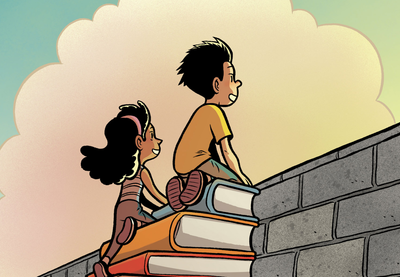Award-winning graphic novelist and cartoonist Gene Luen Yang has had a busy couple of years. Not only did he just wrap up his tenure as the National Ambassador for Young People’s Literature, but he also teaches creative writing in Hamline University’s Writing for Children and Young Adults MFA program. In 2016, he received a MacArthur Foundation “Genius Grant.”
Yang hit his big break in 2006 with his trailblazing graphic novel American Born Chinese, in which he explores themes that he personally grappled with as a youth reconciling his cultural identities. Yang talked with Teaching Tolerance about growing up on comics, teaching high school for 17 years and amplifying diverse identities in his work.

How did identity play into your consumption of comics as a kid and beyond?
I love superheroes. I loved superheroes as soon as I read my first superhero comic. It was a Superman comic. In part, I think it’s because at the heart of every superhero is this idea of dual identity—that Superman has to live both as Superman and as Clark Kent. He kind of has to hide one identity when he’s inhabiting the other one. All that just felt very familiar to me.
I actually think the immigrant story is embedded in the superhero genre, because almost every major superhero out there was created by the children of immigrants and created by these children of Jewish immigrants from Europe. That’s true of Superman, of Batman, of Captain America, almost everybody out there. Spiderman, the X Men, Hulk, Iron Man, all of them.
I think the other thing that I loved about comics is the bar of entry was just so low. Anybody, even a kid in the ’80s, could create their own comic.
What led to your shift from teaching to writing comics for a living?
I taught for a long time. I really liked it. I was actually very reluctant to leave. For the second half of that, I was part-time. We were on a block schedule, so I would go in one day to teach and the other day I would be at home working on comics.
I started making comics and I started teaching around the same time, but comics I always saw as a side gig. I never really expected to make a full-time living at it. When I was starting in the ’90s, the American comic book market was just not very healthy.
In the beginning, I was a self-publisher. Every time I would put out a comic, I would lose money. The turning point was when American Born Chinese came out in 2006.
Do your education and comic worlds ever collide?
Absolutely. In a concrete way. My most recent graphic novel series with First Second Books is called Secret Coders. It’s a middle-grade series that teaches kids the fundamentals of computer science. It’s basically me taking the lessons that I used to teach in my computer science classroom and translating them into comics.
I feel like I’ve learned a lot about teaching through comics by doing this series. I want to keep trying to figure that out. I first used comics in an Algebra II class. … I think, in that class, within math, there’s certain topics that are algorithmic, where you basically have to go through a series of steps. First you do this, then you do this, then you do this, and then you do this. That sort of content worked really well with comics. Instead of reading those steps as text, you actually get to see a visual of what each step looks like. When a student has to recall that, they’re recalling a set of pictures. As a species, we’ve only dealt with words for—I don’t know—in terms of history, it’s the blink of an eye, whereas we’ve dealt with images for much, much longer. For things like memory, images just work better. Comics leverage that aspect of the human mind.
You mentioned in your TEDx Talk that comics became a way for you to give your students a kind of remote control for their learning. What did you mean by that?
There are these different visual storytelling media to convey information. There’s comics, there’s animation, there’s film. Out of all of these different visual media, really the only one that is not time dependent—that is time independent—is comics. When you’re watching a film, when you’re watching a YouTube video, the rate at which that information is transferred to you, the way that story is told to you, is determined by the creator of the content. That is not true for comics. For comics, the rate at which the information flows is firmly in the hands of the reader. A reader can determine how quickly or how slowly she wants to read the comic.
It seems like a really small thing, but I think in educational settings, that control can make a huge difference for certain kinds of content and for certain readers.
What is your Reading Without Walls Challenge, and what inspired you to choose it as the platform for your national ambassador role?
Every national ambassador chooses a platform. About three months before my ambassadorship started, the Republican [presidential primary] debates were going on, and there was a lot of talk about walls in the media. I think that was kind of on our minds. We ended up settling on the idea of reading without walls, and that centers around a challenge. The challenge that I’ve been issuing kids during my ambassadorship is to do one of three things. It’s to set a due date for yourself—you can either do this as a community or individual reader—and by that due date, either read a book about a character who doesn’t look like you or live like you, or read a book about a topic that you might not know anything about, or, three, read a book in a format that you don’t normally read for fun.
If a kid normally only reads chapter books for fun, I want him to try a graphic novel or a book of poetry. If a kid normally only reads comics and graphic novels, then I want them to try something with no pictures in it.
Why those three things in particular?
I think I’m interested in diversity in every sense of the word. For the first challenge, to be perfectly transparent, I want to find a way of maybe driving some demand for books that feature diverse characters, that feature characters from non-mainstream backgrounds, from non-mainstream cultures and religious groups. For topics, I think there’s something about reading a topic that you don’t know anything about, but by the end of that book you know something. That is empowering. That’s happened to me over and over and over again. If I don’t know something and I read a book about it, that book is a way of conquering fear for me about that topic.
America from the very beginning was designed to be a collection of subcultures. I would encourage kids who might feel like outsiders in their immediate vicinity to go and look for that subculture where they belong.
How do you think that comics in particular might help to work toward that goal of learning new things and perspectives in today’s divisive climate?
I have this theory. I have no research to back this up. This is a cockamamie theory that I came up with out of the top of my head: that comics are an incredibly effective way of bridging cultures. For instance—we’re still kind of in the middle of it—there’s this craze for Japanese manga. Japanese manga in America is incredibly popular, right?
I think some of that is because comics translate very well from one language to the other. If I were to watch a Japanese live-action movie, it might be subtitled or it might be dubbed. In both of those cases, the experience that I’m getting as an American is kind of different than the original audience gets. If I read a novel that was originally written in Japanese and then translated into English, the experience that I’m getting is filtered through a translator. If I’m reading a Japanese comic, the words are filtered through a translator, but the actual drawings are not. I’m still seeing the movements of a Japanese artist’s hands on a page. I think there’s something very personal and powerful about it.
I really think the fact that we have so many Japanese manga fans in America is sort of the tip of a larger iceberg that comics can be a way of bridging cultures.
What would you say to young people out there who, like you did, might be struggling with their identities?
Something that was very powerful for me—and this didn’t happen till I was older, till I was in college—was realizing that America is not a single monolithic culture. There’s no such thing, really, as American culture. America from the very beginning was designed to be a collection of subcultures. Just because you don’t fit in with the subculture that you find yourself in now doesn’t mean that there’s not a subculture out there, that is truly a part of America, where you’ll fit. I would encourage kids who might feel like outsiders in their immediate vicinity to go and look for that, to go and look for that subculture where they belong; look for that subculture that calls to them.
Bell is the senior editor for Teaching Tolerance.

